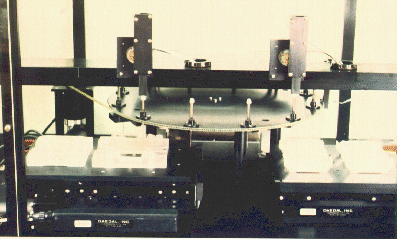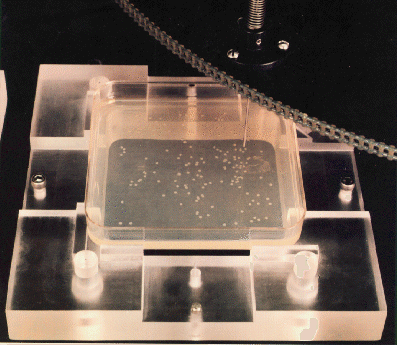

Human chromosomes are far too large to be handled intact by any known biological procedure and therefore must be broken into smaller pieces. These fragments of human DNA are then cloned in colonies of yeast or bacteria cells, which are carefully arranged in ordered libraries so that geneticists can later determine their original chromosomal position. A DNA clone library may consist of 50,000 or more individual fragments, each growing in its own colony.
Assembling DNA clone libraries for subsequent replication and manipulation requires that cells of yeast or bacteria growing at random in Petri dishes be picked up and transferred to a growth medium in microtiter plate wells. The task is traditionally done by hand with a toothpick. It is tedious work and the potential for human error is high.
The automated colony picker eliminates human errors and frees up scientists for more creative endeavors. It consists of two computer-controlled tables, positioned underneath a rotating carousel wheel of twelve plungers, each with a sterilized needle.
To operate the system, a Petri dish containing colonies of yeast or bacteria is placed on one table, and a 96-well microtiter plate is placed on the other. Guided by a digital image that shows the location of colonies in the dish, the first table moves a colony so that a plunger can pick cells onto a needle. The needle is then rotated by the carousel over to the second plunger and the table bearing the microtiter plate moves a well underneath.
The computer activates the second plunger, dipping the needle into the growth medium where some of the cells will be deposited. After retraction from the growth medium, the needle is rotated through a tank filled with sterilizing liquid and made ready for reuse.
In the future, the colony picker will be integrated with other custom automation modules currently under development by the instrumentation group, including an automated image digitization system, a rapid thermal cycler for DNA amplification, and a robotic system for extraction of DNA from cells. When fully operational, the automation designed for LBL's Human Genome Center will establish a production capability to map and sequence millions of base pairs per year.